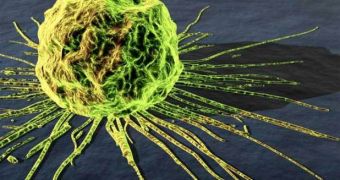When looking at cancerous cells and their healthy neighbors under the microscope, it's very difficult not to distinguish the two, as everything about their appearance and function is different. But a new research shows that the same simply doesn't hold true for the nanoscale level, where formations as small as 20 nanometers are almost identical in the two types of cells. The study also reveals that cells a good distance away from tumors exhibit the same anomalous changes, despite not having direct contact with the cancer. Details are published in the latest online issue of the journal Cancer Research.
Experts from the Northwestern University, which were in charge of the new study, used an optimized form of partial wave spectroscopy (PWS) for their observations, which allowed them to resolve such fine details on the surface of both types of cells. The research permanently validates the “field effect,” a biological phenomenon that relates cancer cells in tumors to healthy cells a good distance away, though admittedly only at the nanoscale.
“Our data provide a strong argument that these nanoscale changes are general phenomena in carcinogenesis and occur early in the process. These changes occur not only in cancer cells but in cells far from the tumor site and are the same in at least three different types of cancer. Given its ability to detect these changes, PWS could be used in the early screening of a variety of cancers,” Northwestern McCormick School of Engineering and Applied Science Professor of Biomedical Engineering Vadim Backman, also the senior author of the new paper, explains.
The building blocks of individual cells can only be viewed at the nanoscale, and, for a long time, experts have determined that they are the main engines that allow for the multitude of processes that are characteristic to cells to take place. With the beginning of cancer formation, these structures may start being influenced by the tumors, Backman argues. He is also a Northwestern University Robert H. Lurie Comprehensive Cancer Center member.
“While very preliminary, if validated, this approach may be of great clinical and biological value. Indeed, the ability to determine cancer risk by interrogating readily accessible tissue may provide an important step forward in cancer screening,” Hemant Roy, M.D., the director of gastroenterology research at NorthShore, concludes. He is also a co-author of the new paper, entitled “Nanoscale Cellular Changes in Field Carcinogenesis Detected by Partial Wave Spectroscopy.”

 14 DAY TRIAL //
14 DAY TRIAL //